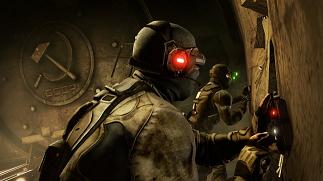 Splinter Cell: Conviction is set to release in under a month on April 15. Many longtime fans are wondering how the multiplayer has turned out with the exclusion of Spies vs. Mercs mode. Well, we have good news – it’s much better than we originally thought it would be.The four multiplayer modes in Splinter Cell: Conviction that we were able to play included: Co-op story, Hunter , Last Stand and Face-off. Each has their unique spin on multiplayer, though the Co-op story is bound to be the most popular.Co-op story is the much hyped addition to the series that gave Spies vs. Mercs the boot – it permits playing as either the Third Echelon’s Archer group or Voron’s Kestrel faction. Allowing two players to complete objectives and missions in tandem, the Co-op story provided thrills around every corner due to the high amount of enemies (even if they aren’t that intelligent) on one level to dispose of.Divided into five levels at this point (St. Petersburg Banya, Russian Embassy, Yastreb Complex, Mozdok Grounds, and Antonov), along with each level having 3-4 chapters, the co-op story is a meaty multiplayer mode. The first chapter, titled “Canal Entrance” was more than 40 minutes long, although it wasn’t a speed run by any means.
Splinter Cell: Conviction is set to release in under a month on April 15. Many longtime fans are wondering how the multiplayer has turned out with the exclusion of Spies vs. Mercs mode. Well, we have good news – it’s much better than we originally thought it would be.The four multiplayer modes in Splinter Cell: Conviction that we were able to play included: Co-op story, Hunter , Last Stand and Face-off. Each has their unique spin on multiplayer, though the Co-op story is bound to be the most popular.Co-op story is the much hyped addition to the series that gave Spies vs. Mercs the boot – it permits playing as either the Third Echelon’s Archer group or Voron’s Kestrel faction. Allowing two players to complete objectives and missions in tandem, the Co-op story provided thrills around every corner due to the high amount of enemies (even if they aren’t that intelligent) on one level to dispose of.Divided into five levels at this point (St. Petersburg Banya, Russian Embassy, Yastreb Complex, Mozdok Grounds, and Antonov), along with each level having 3-4 chapters, the co-op story is a meaty multiplayer mode. The first chapter, titled “Canal Entrance” was more than 40 minutes long, although it wasn’t a speed run by any means.
 Within Hunter mode, players are tasked to eliminate all enemies on the level, no holds barred! This multiplayer mode, along with Last Stand – where players are asked to defend an EMP generator from waves of enemies – are also available through Deniable Ops, an offline and single-player version of the modes. The last multiplayer mode is Face-off, a variation of the Last Stand but with a twist – Splinter Cell: Conviction throws in a live adversary who is out to take down the player, along with the countless waves of computer AI-controlled enemies.Each multiplayer mode allows for players to switch up the difficultly level (Rookie, Normal, Realistic), the pistol, alternate weapons, primary gadgets, secondary gadgets and uniforms. On top of that, players are able to change up the time limit (Unlimited or any variation of 2-5 minutes) along with making it a “pistols only” match or turning off gadgets.
Within Hunter mode, players are tasked to eliminate all enemies on the level, no holds barred! This multiplayer mode, along with Last Stand – where players are asked to defend an EMP generator from waves of enemies – are also available through Deniable Ops, an offline and single-player version of the modes. The last multiplayer mode is Face-off, a variation of the Last Stand but with a twist – Splinter Cell: Conviction throws in a live adversary who is out to take down the player, along with the countless waves of computer AI-controlled enemies.Each multiplayer mode allows for players to switch up the difficultly level (Rookie, Normal, Realistic), the pistol, alternate weapons, primary gadgets, secondary gadgets and uniforms. On top of that, players are able to change up the time limit (Unlimited or any variation of 2-5 minutes) along with making it a “pistols only” match or turning off gadgets.
For the weapons, players can access new weapons via finding them through the co-op story or single-player campaign. Once they pick them up in either/or, the weapons will be added to the weapon stash and are allowed to be upgraded. For an example for an upgrade, here is a look at the AK5-74U.
400 Pts for a Reflex Sight (increases zoom)
250 Pts for Hollow Point Ammo
250 Pts for a Laser Sight (increases accuracy)
Each weapon, gadget and uniform can be upgraded, with the uniform allowed for a maximum of three times. For the weapons and gadgets, each time they are upgraded, the following upgrade increases in cost. If players are curious about the outfits, here’s a quick look at what is offered:
 Voron’s Spetsnaz Tactical Assault Suit (elite soldier)
Voron’s Spetsnaz Tactical Assault Suit (elite soldier)
Voron’s SV8 Tactical Concealment Suit (government employee)
Voron’s SV1 Special Ops Suit (covert ops)
Third Echelon’s T1C9 Tactical Concealment Suit (mercenary)
Third Echelon’s C1C9 Casual Concealment Suit (urban setting)
Third Echelon’s “Special Agent” (aka Sam Fisher suit)
Third Echelon’s Mark 7 Special Ops Suit (special ops)
All in all, our sessions managed to raise the hairs off the back of our neck as the tension was always at a high as we avoided conflict and took down the opposition with a stealth attack from behind. Every once in awhile we would run in, guns a blazing, and take down the unnamed mercenaries who stood no chance against two special ops agents that hurdled rails, climbed up drainage pipes, and shot out every light in the room to avoid detection.


